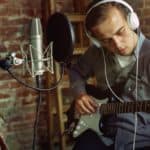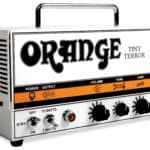Guitars are loud instruments. This is both an advantage and a disadvantage.
On the one hand, the louder the guitar, the better the experience. A properly loud guitar sound, with the right settings, and the right effect pedals, will create wonders.
You can bring to life unique pieces of music to marvel at your audience or just amuse yourself.
On the other hand, loud guitars are detested by many people. So, do not act surprised when the police officer arrives at your house, saying that a neighbor of yours complained to the authorities because of your playing.
Now, you can argue that it’s possible to play a disconnected electric guitar. And yes, you’re right.
But is it the same experience? Of course not!
We all know every guitarist wants to make their guitar sound effectively. So, we highly encourage you to play with headphones.
Headphones are useful in a variety of ways, and here we’ll share the top 5 ways in which you can combine headphones and a guitar.
The top ways to play guitar with headphones are using an amp, a multi-effect pedal, an audio interface connected to a smartphone or PC, and playing with a micro-amp. Consider that headphones should be wired ones since Bluetooth devices create latency.
Playing guitar when wearing headphones has lots of advantages.
Let’s see why you should try them now and then, and, most importantly, how to do it.
1. Multi-effect Pedals
Multi-effect pedals are devices that come with a wide variety of effects and sounds to modify the guitar’s tone.
The majority of the multi-effect pedals come with headphone jacks on them.
These outputs come with the name “line out output”, or simply “headphones.”
Naturally, not every multi-effect pedal in the market comes with a headphone jack. So, before buying, always check that the one you are paying for does indeed come with a line-out output (in case you want to play with headphones, of course).
However, even if the multi-effect pedal comes with a headphone output, some may require you to purchase an extra adapter.
All in all, it’s worth investing in one of these because multi-effect pedals can be transported almost anywhere (especially when compared with an amp).
Not to mention, you can play guitar and listen to some interesting tunes and settings, which overall, will make playing guitar with headphones a richer experience.
2. Guitar Amp
Probably the most obvious (or common) option on the list.
Plugging your headphones directly into the guitar amp converts the guitar signal and passes it through to your ears.
A word of advice, though. Make sure that your amp has a headphones jack on it. Just like the multi-effect pedal, look for the “line out” output.
Otherwise, if you put the headphones in a different output, you run the risk of permanently ruining your amp.
So, if you’re unsure, better not to venture here at all.
Also, we recommend you turn the master volume down to zero before plugging the headphones in. Then, you can turn it up until you reach a comfortable and desired level.
That way, you’re preventing hearing damage.
All in all, using a guitar amp is one of the most appropriate and direct ways to play guitar with headphones.
3. Computer or Laptop (with Audio Interface)
Not every musician has a guitar amp. After all, they might be a bit expensive.
However, we strongly believe that, in this era, most people have a computer at home.
This device is fantastic to function as a guitar amp replacement and to play guitar with headphones.
All you need is your Mac or computer and an audio interface device. Plug the guitar into the audio interface, and then connect it to the PC.
Not only you’ll be able to play guitar with headphones, but also to record your music.
Consider that if you already have effect pedals, you can connect them to the guitar and the audio interface.
4. Cellphone or Smartphone (with Audio Interface)
Just like with the PC/Mac method, you can use an audio interface with your smartphone or tablet.
This option is even simpler, because one may not have a guitar amp, and one could even lack a computer at home, but rarely one won’t have a smartphone.
Not to mention, playing guitar this way is comfortable. Just grab your instrument, and put your phone in your pockets.
Now you’re set to play whenever you go to!
5. Micro-amp
A micro-amp is, well, a tiny amp.
These are so small that they fit in the gig bag, allowing you to take them anywhere.
Naturally, the power of a micro-amp doesn’t meet the expectations of a regular amp. Nonetheless, it’s a fantastic addition to rehearsing flawlessly.
Micro-amps come with headphone jack outputs but remember that, in some cases, you may need to purchase an adapter.
What headphones should you use for guitar?
Any standard wired set of headphones will work on your guitar amp, multi-effect pedal, or smartphone.
However, it’s safe to mention that some models are more appropriate for this task than others.
Most experts recommend using an Audio-Technica ATH-M50x. What makes these stand out from the rest is their utility for studio sessions.
To be more precise, the Audio-Technica ATH-M50x provides optimal sound quality that allows you to listen to everything in a sound mix.
Another great choice is the Beyerdynamic DT 1990 PRO Open Studio Headphones.
Once again, this product is designed to meet studio recording needs. Bear in mind, though, that the Beyerdynamic DT 1990 PRO Open Studio headphones are quite expensive in comparison with the rest.
If money is not a problem for you, then you should check these out.
A third and fourth option is the Sennheiser HD 598SR and the Sennheiser Pro Audio HD 650 Open Back Professional Headphones. These are some reputable models in the headphone industry that will guarantee optimal sound quality.
Lastly, we can mention the Sony MDR-7506.
These are low-budget choice that helps you save money while also getting quality and decent products.
Do guitar amps have headphone jacks?
Most often than not, guitar amps come with headphone jack output.
The problem is that the headphones plug may not fit the amplifier output.
Luckily, the solution is as simple as getting an adapter.
Remember to verify that you’re connecting the headphones to the right output, otherwise, you can damage your amp.
Can you play guitar with Bluetooth headphones?
Although it is possible to play guitar with Bluetooth headphones, we highly discourage this activity.
The main problem is latency. Latency is known as the delay produced between two signals: the one that’s sent, and the one received.
There might be some counted exceptions in which such a delay won’t be too noticeable. Unfortunately, this is a rare case scenario.
Most often than not, the delay (or latency) will be too obvious not to notice it… which sucks!
So, keep your Bluetooth headphones to listen to your favorite playlists and albums, but not for rehearsing with your bass or electric guitar.
Is it a good idea to practice guitar with headphones?
Wearing headphones while playing guitar is a great idea.
First of all, it allows you to rehearse without bothering the rest.
After all, many players can’t enjoy the sound of their guitars to the full just because they can’t bother their neighbors or roommates.
As a result, guitarists end up playing unplugged, which is great for practicing, but relatively boring.
That is unless you play with the headphones on.
In that case, you have the freedom to play as loud as you can (watch out not to make yourself deaf!) because the sound will be listened to by yourself solely.
What’s more, practicing with headphones is perfect for optimal listening. The better you listen to your playing, the easier it becomes to detect mistakes and errors.
Not to mention, it’s a fantastic exercise for sharpening your ears.
So there you go, headphones improve your hearing abilities, and your playing techniques (as a result of better listening), and allow you to play without annoying other people with the sound of your guitar.
Can you rehearse and play live with headphones?
Some guitarists do wear headphones when playing live performances.
The truth is, live concerts are loud and a bit of a mess.
It’s relatively easy to misinterpret sounds, or even to not be able to hear you at all.
The solution, then, is simply to work with some headphones.
These avoid external noises and help the player focus on the sound they produce.
For rehearsals, headphones could work as well. However, it would be great not to use them at least for a couple of minutes, just to check how the band sounds as a whole.
Other than that, you can give headphones a try during practice sessions or live performances.
Who knows? Maybe it does enhance your playing skills.
Playing guitar through an actual speaker feels different
There is a wide difference between playing guitar with headphones and playing without them.
Not only on the experience itself but also on how it sounds.
Just think about it. When playing without headphones, thus, directly from the speaker, external sounds will interfere with the final result.
The sound waves travel through the air when playing with a speaker. On the contrary, the signal goes directly into your ears when playing with headphones.
Naturally, playing with headphones helps you perceive your music in a more detailed form.
Bear in mind, though, that no one is better than the other. It always has to do with the musician preferences, and with the time and place you’re playing at.
Cabinet emulation when playing guitar through headphones
The cabinet emulation helps to provide the tonal effects of a guitar running through an amp, without actually being connected to one.
The difference is not as clear when compared to playing guitar with a real speaker or amp.
Either one or the other will work with no problems at all.

Hello there, my name is Ramiro and I’ve been playing guitar for almost 20 years. I’m obsessed with everything gear-related and I thought it might be worth sharing it. From guitars, pedals, amps, and synths to studio gear and production tips, I hope you find what I post here useful, and I’ll try my best to keep it entertaining also.





